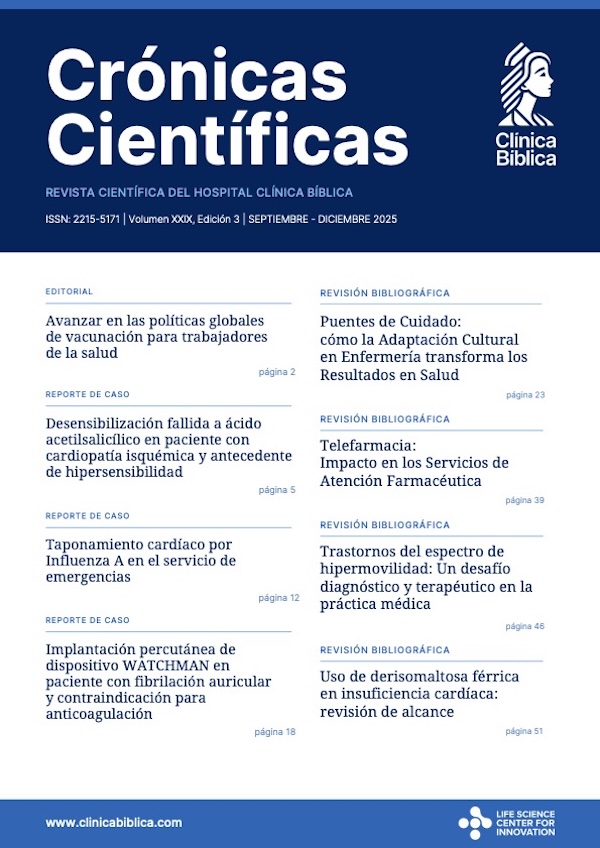- Visto: 1096
Revisión Bibliográfica
Pielonefritis enfisematosa: patogénesis, diagnóstico y manejo
Emphysematous pyelonephritis: pathogenesis, diagnosis and treatment
Edición XIII Setiembre - Diciembre 2019
DOI: https://doi.org/10.55139/QXQZ3527
APA (7ª edición)
Castro-Corrales, V., Zumbado-Vásquez, R., Hines-Chaves, K. (2019). Pielonefritis Enfisematosa. Crónicas Científicas, 13(13), 20-19. https://doi.org/10.55139/QXQZ3527.
Vancouver
Castro-Corrales V, Zumbado-Vásquez R, Hines-Chaves K. Pielonefritis Enfisematosa. Cron cient. 22 de julio 2019; 13(13): 20-29.
Dra. Valeria Caro Pizarro
Médico General, San José, Costa Rica.
Investigador Independiente.
Miembro del Colegio de Médicos y Cirujanos de Costa Rica.
Costa Rica.
Dra. Rebeca Zumbado Vásquez
Médico General, Heredia, Costa Rica.
Investigador Independiente.
Miembro del Colegio de Médicos y Cirujanos de Costa Rica.
Costa Rica.
Dr. Kevin Hines Chaves
Médico General, San José, Costa Rica.
Investigador Independiente.
Miembro del Colegio de Médicos y Cirujanos de Costa Rica.
Costa Rica.
Resumen
La pielonefritis enfisematosa es una infección necrotizante del sistema urinario, producida por bacterias formadoras de gas. Su mayor incidencia se identifica en los pacientes diabéticos o inmunocomprometidos. Su diagnóstico es radiológico al confirmar la presencia de gas en el parénquima renal o tejido perirrenal, debido a que la clínica solo orientará al proceso infeccioso de origen renal.
Aún se debate su debido tratamiento, sin embargo, los autores que estudian el tema concuerdan en el cambio del manejo para preservar el parénquima renal en contraste con el manejo anterior, el cual correspondía a la nefrectomía. En esta revisión bibliográfica, se proveerá información acerca de la patogénesis, el diagnóstico, los factores pronósticos y las diferentes opciones que se han estudiado para su adecuado manejo.
Palabras claves
Pielonefritis enfisematosa, drenaje percutáneo, nefrectomía.
Abstract
Emphysematous pyelonephritis is a necrotizing infection of the urinary caused by gas producing bacteria. It has a higher incidence in diabetic or immunocompromised patients. Its diagnosis is made by confirming the presence of gas in the renal parenchyma or perirenal tissue by radiological images, because the clinical aspects will only orient to an infectious process of renal origin.
The corresponding treatment is still debated however the authors agree on the change of management towards the preservation of the renal parenchyma in contrast to the previous management which corresponded to nephrectomy. In this review information about the pathogenesis, diagnosis and different options that have been studied for the proper management for emphysematous pyelonephritis will be provided.
Keywords
Emphysematous pyelonephritis, percutaneous drainage, nephrectomy.
Bibliografía
Agrawal, S., Kalathia, J., Chipde, S. y Agrawal, R. (2015). Nephron-sparing surgery in case of emphysematous pyelonephritis. Urology Annals, 7(4), 504-506. doi:10.4103/0974-7796.162211
Ezzouine, H., Cherkaoui, A. y Benslama, A. (2016). Emphysematous pyelonephritis: Dilemma between radical or conservative treatment (report of 3 cases). Community Acquired Infection, 3(2), 61-67. doi:10.4103/2225-6482.184918
Kim, N. y Machnicki, S. (2015). Emphysematous pyelonephritis. Applied Radiology, 44. Recuperado de https://appliedradiology.com/articles/emphysematous-pyelonephritis
Lamy, S., Alsharif, M., Mohammedkhalil, A., Alsaywid, B. y Alhazmy, A. (2015). Emphysematous pyelonephritis: Is nephrectomy warranted? Urology Annals, 7(4), 494-498. doi:10.4103/0974-7796.158503
Misgar, R., Mubarik, I., Wani, A., Bashir, M., Ramzan, M. y Laway, B. (2016). Emphysematous pyelonephritis: A 10-year experience with 26 cases. Indian Journal of Endocrinology and Metabolism, 20(4), 475-481. doi:10.4103/2230-8210.183475
Nana, G. R., Brodie, A., Akhter, W., Karim, O. y Motiwala, H. (2015). Nephroureterectomy for emphysematous pyelonephritis: An aggressive approach is sometimes necessary. A case report and literature review. International Journal of Surgery Case Reports,10, 179-182. doi:10.1016/j.ijscr.2015.03.051
Pontin, A. R. y Barnes, R. D. (2009). Current management of emphysematous pyelonephritis. Nature Reviews Urology, 6(5), 272-279. doi:10.1038/nrurol.2009.51
Rao, V. V., Pathapati, D., Shinkar, P., Kumar, S., Jha, Dattatreya, P., . . . Chigurupati, M. (2017).
Asymptomatic emphysematous pyelonephritis - positron emission tomography computerized tomography aided diagnostic and therapeutic elucidation. Indian Journal of Nuclear Medicine, 32(1), 42-45. doi:10.4103/0972-3919.198477
Shah, V., Khade, A. y Lad, S. (2016). Pathology of emphysematous pyelonephritis: A study of 11 cases. Medical Journal of Dr. D.Y. Patil University, 9(6), 722-726. doi:10.4103/0975-2870.194191
Sokhal, A. K., Kumar, M., Purkait, B., Jhanwar, A., Singh, K., Bansal, A. y Sankhwar, S. (2017). Emphysematous pyelonephritis: Changing trend of clinical spectrum, pathogenesis, management and outcome. Türk Üroloji Dergisi/Turkish Journal of Urology, 43(2), 202-209. doi:10.5152/tud.2016.14227
Somani, B. K., Nabi, G., Thorpe, P., Hussey, J., Cook, J. y N’Dow, J. (2008). Is Percutaneous Drainage the New Gold Standard in the Management of Emphysematous Pyelonephritis? Evidence From a Systematic Review. Journal of Urology, 179(5), 1844-1849. doi:10.1016/j.juro.2008.01.019
Torres, L., García, M., Serrano, E., Maldonado, E., López, V., Montoya, G. y Moreno-Palacios, J. (2016). Factores pronósticos de morbimortalidad en pacientes con pielonefritis enfisematosa. Revista Medica Del IMSS, 54, S156-S161. Recuperado de http://search.ebscohost.com.ezproxy.sibdi.ucr.ac.cr:2048/login.aspx?direct=true&db=a9h&AN=120913933&site=ehost-live&scope=site
Tilden, W., Valliani, S. y Chana, H. S. (2015). Severe emphysematous pyelonephritis: Conservative management plus image-guided percutaneous drainage prior to successful elective nephrectomy. A case report and review of the literature. BJR|case Reports, 1(1), 20140004-20140007. doi:10.1259/bjrcr.20140004
Ubee, S. S., Mcglynn, L. y Fordham, M. (2010). Emphysematous pyelonephritis. BJU International, 107(9), 1474-1478. doi:10.1111/j.1464-410x.2010.09660.x
Vishnu, V., Vardhana, R. y Panduranga, K. (2018). A clinical study of emphysematous pyelonephritis. IAIM, 5(2), 150-159.
Wang, H., Zhu, X., Xu, X., Li, G., Liu, N., He, F. y Man, Lb. (2017). Emphysematous Pyelonephritis Treated with Vacuum Sealing Drainage. Chin Med,130, 247‐248. doi: 10.4103/0366‐6999.198021
Wiesel, S., Gutman, A., Abraham, J. E. y Kiroycheva, M. (2017). Foley Follies: Emphysematous Pyelitis from Instrumentation in Obstructive Uropathy. Cureus, 9(8), 1612-1617. doi:10.7759/cureus.1612
Arch Intern Med. 2000 Mar 27;160(6):797-805.
Emphysematous pyelonephritis: clinicoradiological classification, management, prognosis, and pathogenesis.
Huang JJ1, Tseng CC.
Aswathaman K, Gopalakrishnan G, Gnanaraj L, Chacko NK, Kekre NS, Devasia A. Emphysematous pyelonephritis: outcome of conservative management. Urology. 2008; 71: 1007-1009.
Huang JJ, Tseng C. Emphysematous pyelonephritis. Cli-nicoradiological classification, management, prognosis,and pathogenesis. Arch Intern Med 2000;160:797-805.
Int Urol Nephrol. 2009 Dec;41(4):959-66. doi: 10.1007/s11255-009-9552-y. Epub 2009 Apr 30.
Retrospective analysis of clinical profile prognostic factors and outcomes of 19 patients of emphysematous pyelonephritis.
Khaira A1, Gupta A, Rana DS, Gupta A, Bhalla A, Khullar D.
APA (7ª edición)
Castro-Corrales, V., Zumbado-Vásquez, R., Hines-Chaves, K. (2019). Pielonefritis Enfisematosa. Crónicas Científicas, 13(13), 20-19. https://doi.org/10.55139/QXQZ3527.
Vancouver
Castro-Corrales V, Zumbado-Vásquez R, Hines-Chaves K. Pielonefritis Enfisematosa. Cron cient. 22 de julio 2019; 13(13): 20-29.
Esta obra está bajo una licencia internacional Creative Commons: Atribución-NoComercial-CompartirIgual 4.0 Internacional (CC BY-NC-SA 4.0)

Realizar búsqueda
Última Edición
Ediciones Anteriores






